|
Printables |
PowerPoints |
Online exercises |
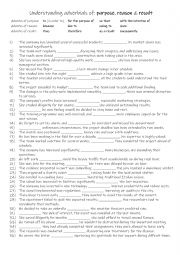
|
B1+ -C1 Understanding 12 adverbials of purpose, reason & result 1
Learning to use adverbials of purpose, reason, and result enhances clarity and coherence in communication. These adverbials allow students to express intentions, causes, and outcomes clearly, making their speech and writing more logical and well-structured. Mastering these adverbials also helps them link ideas smoothly, providing a stronger flow i...
Level: intermediate
Age: 9-100
Type:
Downloads: 105
|
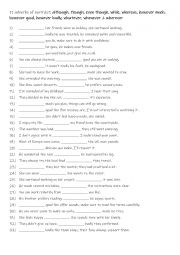
|
B1+ -C1 11 adverbs of contrast although, though, even though, while, whereas, however much, however good, however badly, whatever, whenever & wherever
Learning adverbs of contrast is essential for expressing nuanced ideas and showing the relationship between opposing thoughts or actions. They allow students to introduce exceptions, concessions, and unexpected outcomes, enriching both written and spoken communication. Mastering these adverbs also helps in constructing complex sentences that reflec...
Level: intermediate
Age: 9-100
Type:
Downloads: 125
|
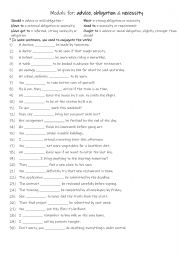
|
A2+-B1+ Modal Verbs for Advice, Obligation, and Necessity
Students familiarise themselves with the 6 modal verbs and their usage. Then they read the sentences to see which modal verb is needed to complete the gap-fill. Answers on page 2.
Level: intermediate
Age: 9-100
Type:
Downloads: 107
|
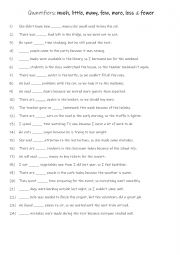
|
A2-B1 Quantifiers - much, little, many, few, more, less & fewer
Students familiarise themselves with the 7 quantifiers and their use and meanings . Then they read the sentences to see which quantifier is needed/ suitable to complete the gap-fill.
Level: elementary
Age: 8-100
Type:
Downloads: 102
|
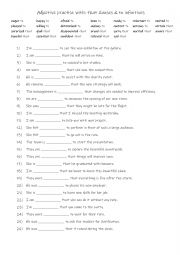
|
B1-B2 Adjective practise with that clauses & to infinitives
Students familiarise themselves with the the use of adj + that & adj + to , their use and grammatical formation. Then they read the sentences to see which adj + preposition is requires to complete the gap-fill. Answers on page 2.
Level: intermediate
Age: 10-100
Type:
Downloads: 113
|
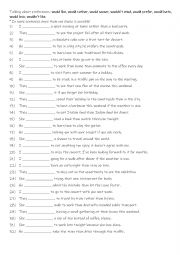
|
B1+-C1 Talking about preferences -would like, would rather, would sooner, would not mind, would prefer, would hate, would love & would not like.
Students familiarise themselves with the different ways of expressing their preferences and grammatical usage. Then they read each sentence to see which one is the most suitable to complete the gap-fill. Each form is used 4 times. Answers on page 2.
Level: intermediate
Age: 10-100
Type: worksheet
Downloads: 117
|
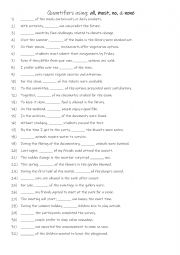
|
A2-B1 Quantifiers using: all, most, no, & none
First students familiarise themselves with the 4 quantifiers and their use. Then they read the sentences to work out which quantifier is required to complete the sentence. Answers on page 2.
Level: intermediate
Age: 9-100
Type:
Downloads: 112
|

|
A2+-B1 Linking words for amounts: neither, nor, both & either
First students familiarise themselves with the 4 words and their uses. Then they read the sentences to work out which linker is needed to complete the gap-fill.Each linker is used 7 times. Answers on page 2.
Level: intermediate
Age: 9-100
Type:
Downloads: 120
|

|
A1+-A2 Jobs - Who do I need to phone if....
Students familiarise themselves with the 25 jobs and what they do. Then students read each scenario and write down the type of job that will solve the problem. Answers on page 2.
Level: elementary
Age: 7-100
Type:
Downloads: 126
|
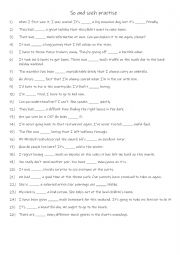
|
A2-B1 Intensifiers: so and such practise
Learning how to use "so" and "such" is important because they help students emphasise their statements and make their speech and writing more precise and expressive.Mastering "so" and "such" instead of relying on words like "very" and "really" adds variety to language, making it more dynamic and interesting. First students familiarise themselves wi...
Level: intermediate
Age: 8-100
Type:
Downloads: 130
|
|
|
|
|












